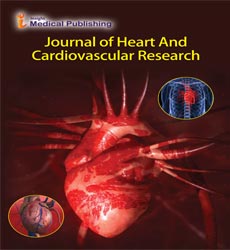ISSN : ISSN: 2576-1455
Journal of Heart and Cardiovascular Research
Utilizing Cardiac Biomarkers for Cardiovascular Risk Management in Cancer Patients Receiving Cardiotoxic Treatments
Yijun Liu*
Department of Vascular Surgery, Zhenjiang University, Zhenjiang, China
- *Corresponding Author:
- Yijun Liu
Department of Vascular Surgery, Zhenjiang University, Zhenjiang,
China,
E-mail: yujinliu@gmail.com
Received date: May 06, 2024, Manuscript No. IPJHCR-24-19367; Editor assigned date: May 09, 2024, PreQC No. IPJHCR-24-19367 (PQ); Reviewed date: May 23, 2024, QC No. IPJHCR-24-19367; Revised date: May 30, 2024, Manuscript No. IPJHCR-24-19367 (R); Published date: June 06, 2024, DOI: 10.36648/2576-1455.8.2.68
Citation: Liu Y (2024) Utilizing Cardiac Biomarkers for Cardiovascular Risk Management in Cancer Patients Receiving Cardiotoxic Treatments. J Heart Cardiovasc Res Vol.8 No.2: 68.
Description
Serum biomarkers are a vital device within the pattern chance evaluation and determination of cardiovascular illness in cancer patients accepting cardiotoxic cancer medications. Increments in cardiac biomarkers counting cardiac troponin and natriuretic peptides can be utilized to direct start of cardioprotective medicines for cancer patients amid treatment and to screen the reaction to cardioprotective medicines and they too offer prognostic esteem. This position articulation analyzes the role of cardiac biomarkers within the management of cancer patients. The characteristics of the most two biomarkers troponin and natriuretic peptides are talked about, the connect to the instruments of cardiovascular poisonous quality, and the prove for their clinical utilize in observation amid and after anthracycline chemotherapy, trastuzumab and HER2-targeted treatments, vascular endothelial development calculate inhibitors, proteasome inhibitors, resistant checkpoint inhibitors, cyclophosphamide and radiotherapy. There are a developing number of Cardiovascular Illnesses (CVD) in cancer patients amid and after cancer treatment. This comes about from the complex interaction of a few components: Moved forward survival of cancer patients, the maturing populace and the related expanded frequency of preexisting CVD and hereditary inclination. Other variables incorporate enthusiastic and physical push, safe dysregulation (expanded or diminished) and particularly Cardiovascular (CV) poisonous quality of particular cancer medicines (chemotherapy, focused on treatments, science and illumination). The pathways of appraisal and scheduling of cancer treatment inside oncology and haemato-oncology units give a one of a kind opportunity to audit the CV wellbeing of cancer patients some time recently cancer treatment begins, and to optimize the administration of preexisting CVD. Besides, when cancer treatments in patients with known lifted CVD chance profile are demonstrated, the potential to screen cancer patients for early prove of CVD and mediate earlier to the development of built up CVD may be a unused wilderness in CVD avoidance. Standard hazard appraisal is suggested and as of late the Heart Disappointment Affiliation (HFA) Cardio-Oncology Ponder Bunch and the Universal Cardio- Oncology Society distributed hazard stratification proformas for a run of cardiotoxic cancer treatments. Observation techniques amid treatment are suitable for cancer patients accepting possibly possibly cardiotoxic cancer therapies, particularly those at expanded CV hazard, conjointly in cancer survivors taking after treatment where the hazard of late CVD is recognized. Estimation of serum cardiac biomarkers speaks to a doable and promising opportunity to assist in standard chance stratification, determination of early CVD amid and taking after treatment, distinguishing proof of cancer patients who may advantage from cardioprotective medicines while proceeding oncology treatment, and prognostic esteem to recognize patients who may require long-term CVD follow-up.
Cardiac biomarkers
The current prove for cardiac biomarker estimation in various cancer medicines with known CV poisonous quality, with a center on cardiotoxic cancer medicines causing Heart Failure (HF) and long run improvements in this field. A parallel HFA position paper addresses the part of CV imaging in cancer patients getting cardiotoxic cancer treatments counting pattern chance evaluation and observation. These approaches (CV biomarkers and imaging) are synergistic and should be connected together. Numerous biomarkers are not solely created by the heart, but are delivered by a few organs in reaction or in affiliation with CVD. Hence, few biomarkers proposed for clinical utilize satisfy all five criteria. Cardiac Troponins (cTn) and Natriuretic Peptides (NPs) are prevalent and most writing bolsters their utilize for determination, monitoring and forecast of CVD. Clinical hone in cardiology has centered on NPs and cTn where inquire about over the final 30 years has affirmed that both these biomarkers meet the five criteria sketched out over at best for different CVD, e.g. intense coronary syndrome, acute and incessant HF. The point and center of this position explanation is to assist give the cardiology, oncology, haemato-oncology and common therapeutic communities with a system to direct the execution of cardiac biomarkers presently and within the future to distinguish and avoid CVD and Major Adverse Cardiovascular Occasions (MACE) in cancer patients and survivors. MACE incorporate HF and Cleared out Ventricular Brokenness, intense coronary syndromes, accelerated fringe vascular malady, intense atrial and ventricular tachyarrhythmias, progressed conduction illness, aspiratory blood vessel hypertension, venous thromboembolism and safe systemic hypertension.
Open Access Journals
- Aquaculture & Veterinary Science
- Chemistry & Chemical Sciences
- Clinical Sciences
- Engineering
- General Science
- Genetics & Molecular Biology
- Health Care & Nursing
- Immunology & Microbiology
- Materials Science
- Mathematics & Physics
- Medical Sciences
- Neurology & Psychiatry
- Oncology & Cancer Science
- Pharmaceutical Sciences
